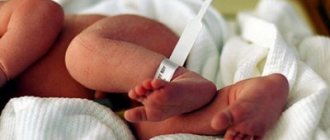Commentary to Art. 106 Criminal Code
1. The murder of a newborn child by a mother becomes a crime with mitigating circumstances if it occurs in the presence of one of three signs: a) during or immediately after childbirth; b) in a psychotraumatic situation or c) in a state of mental disorder that does not exclude sanity.
2. For the first mitigating circumstance, a newborn, according to forensic medicine, is a child under one day of age. The legislator assumes that during this period the woman in labor has certain deviations in her psychophysical state that affect her ability to understand her behavior and make decisions. If in a particular case it turns out that childbirth did not cause any mental disorders, but nevertheless the mother took the life of the child during or immediately after childbirth, then even then the act is qualified under Art. 106 of the Criminal Code.
3. For two other mitigating circumstances, a newborn is a child under four weeks of age. What is common to the types of murder under consideration is that the subject of the crime, i.e. a mother who has reached the age of 16 is in a special psychophysical state caused either by a traumatic situation or by mental disorders that do not exclude sanity.
A psychotraumatic situation can arise before and after childbirth, as a result of which the mother of a newborn experiences an accumulation of negative emotions, which reduces her ability to adequately evaluate her actions, limits her ability to control her actions and predict their possible consequences.
4. The murder of a newborn is possible both with sudden and premeditated direct or indirect intent.
5. Complicity in the form of co-execution of persons in the murder of a newborn child by a mother entails liability under paragraph “c” of Part 2 of Art. 105 of the Criminal Code.
Characteristics of the subject of murder by the mother of a newborn child based on statistical data
The subject of a crime is a person who has committed a socially dangerous act and is capable, in accordance with the law, of incurring criminal liability for it [4, p. 9]. The subject of infanticide is special. This can only be the mother of a newborn child, a sane person who has reached the age of sixteen. The concept of “mother”, as a rule, is associated with the fact that a woman gives birth to a child she bears, feeds it and raises it in the future.
Let's consider the statistics of the Judicial Department at the Supreme Court of the Russian Federation on sentencing in cases of murder by a mother of a newborn child in Russia over the past 10 years [3]:
| Year | 2009 | 2010 | 2011 | 2012 | 2013 | 2014 | 2015 | 2016 | 2017 | 2018 | 1st half2019 |
| Number of people convicted under the main article | 87 | 65 | 66 | 60 | 75 | 42 | 45 | 58 | 42 | 33 | 15 |
| Additional qualifications | 0 | 0 | 1 | 0 | 0 | 1 | 0 | 0 | 0 | 0 | 0 |
Since 2021, official statistics have been kept on the social characteristics of mothers who killed their newborn child. Based on it, a portrait of criminals can be drawn up.
Age of the convicts at the time of the crime [3]:
| Year | Total crimes | 14–17 years old | 18–24 years old | 25–29 years old | 30–49 years old | 50 years and older |
| 2017 | 42 | 0 | 12 | 11 | 19 | 0 |
| 2018 | 33 | 2 | 5 | 3 | 23 | 0 |
| 1 floor 2019 | 15 | 0 | 4 | 0 | 11 | 0 |
According to statistics, most crimes are committed by women aged 30–49 years. About 15% of women who commit neonatal homicide have at least one child under 3 years of age. The average age at which modern women give birth to their first child is approaching 30 years and older. A second pregnancy, after 35 or 38 years, becomes almost inevitable if a woman wants to fully recover after her first birth, which corresponds to information from the World Health Organization.
In addition, women between the ages of 25 and 29 committed murder of a newborn child in almost 15% of cases. The most typical reasons are significant financial difficulties and unfavorable living conditions; egocentrism: according to the woman, the child interferes with her personal happiness, career growth, etc.; bastardy; heredity (genetic diseases and predisposition) and some others.
Education of mothers who killed a newborn [3]:
| Year | Total crimes | higher | average | average overall | basic general, initial |
| 2017 | 42 | 2 | 15 | 15 | 10 |
| 2018 | 33 | 1 | 9 | 15 | 8 |
| 1 floor 2019 | 15 | 0 | 3 | 8 | 4 |
Data on education indicate that the majority of mothers who commit murder of a newborn have secondary, secondary general, basic general and primary education.
Occupation of mothers who committed a crime [3]:
| Year | Total crimes | workers | agricultural workers | employees of a commercial or other organization | pupils and students | disabled | able-bodied persons without a regular source of income | judges, court employees | persons of other occupations |
| 2017 | 42 | 6 | 0 | 0 | 1 | 1 | 30 | 1 | 3 |
| 2018 | 33 | 8 | 1 | 2 | 0 | 1 | 17 | 0 | 1 |
| 1 floor 2019 | 15 | 6 | 0 | 0 | 1 | 0 | 8 | 0 | 0 |
The majority of women who committed a crime under Art. 106. of the Criminal Code of the Russian Federation are able-bodied persons who do not have a permanent source of income.
Since 2021, statistics have been kept on the location of the crime [3]:
| Year | Total crimes | Committed crimes in rural areas | Committed crimes in the administrative centers of the constituent entities of the Russian Federation |
| 2018 | 33 | 13 | 8 |
| 1 floor 2019 | 15 | 7 | 3 |
The table shows that crimes under Art. 106 of the Criminal Code of the Russian Federation gravitate towards rural areas and small towns (76% of all in 2021 and 80% in 2019). Crimes committed in large and major cities, which are the administrative centers of the constituent entities of the Russian Federation, can be explained by both the wide range of urban populations (from 250 thousand people to million-plus cities) and the high population density.
A large number of these crimes in rural areas and small towns can be explained by the depression of this area: low standard of living, lack of work and, as a consequence, lack of livelihood. It must be emphasized that the depressiveness of rural areas has been growing in recent years, medical care has become unavailable, FAPs (medical and midwifery stations), kindergartens, schools, libraries, and cultural centers are closing.
Thus, it is possible to draw up a summary portrait of the mother-killer of a newborn child: she is a woman of working age, who does not have a higher education, does not have a permanent place of work, and lives in a rural area or a small town.
The relationship with the child’s father in such women, as a rule, is fragile, which fully explains the woman’s fear and reluctance to inform her partners and relatives about the pregnancy, as well as the fear of everyday difficulties when raising a child. Based on this, many women hide or deny the presence of pregnancy, and therefore refuse obstetric and gynecological care, which undoubtedly indicates that the mother does not intend to leave her child.
When describing the characterological characteristics of the moral and psychological level, the criminal’s personal immaturity, lack of a criminal past, passivity, low intellectual level, anxiety, and self-doubt are noted. Many have psychological problems that precede a psychotraumatic situation, which includes the fear of “shame” in front of relatives for an unwanted pregnancy; this situation, with the approach of childbirth, causes a special emotional state in women in labor, which provokes the commission of aggressive actions against their child. Emotional tension has a significant impact on a woman’s behavior and consciousness.
It is under such circumstances that more brutal methods of committing crimes are often encountered. This is due to the fact that at the time of labor, women most often give birth without qualified medical care, alone at home or nearby, but in such a way as to hide the fact of childbirth from others. Such a traumatic environment further aggravates the natural psychological problems associated with a woman’s childbirth period. As a result, exhaustion of mental activity occurs, panic states develop, which narrows the ability of the mother in labor to evaluate her actions, as a result of which brutal murders of newborns are committed.
Thus, based on the above, we can say that the unfavorable environment during childbirth is a factor provoking the murder of a newborn child. A mother planning to commit this crime goes into a state of marginality (borderline, uncertainty), from which it is still possible to remove her if there is an effective system for preventing such acts.
Literature:
- Babiy, N. A. Murders under privileged circumstances and other crimes against life. –M., 2013. –152 p.
- Gernet, M. N. Infanticide in Russian law. – M.: Ladomir. 2004 –739 p.
- Data from judicial statistics // Judicial Department of the Supreme Court of the Russian Federation. URL: https://www.cdep.ru/index.php?id=79 (access date: 12/18/2019).
- Special subject of the crime. Monograph / Ustimenko V.V. - Kharkov: Vishcha school, 1989. - 104 p.
Second commentary to Art. 106 of the Criminal Code of the Russian Federation
1. The murder of a newborn child by a mother (Article 106 of the Criminal Code) is characterized by signs that distinguish it from the main elements of murder:
a) special characteristics of the subject of the crime and the victim; b) the time the crime was committed;
c) the emotional state of the person guilty of committing a crime.
2. The subject of the type of murder under consideration can only be the biological (in the case of surrogacy - surrogate) mother, who has reached the age of sixteen at the time of the crime.
3. The legislation of the Russian Federation defines obstetric, pediatric and forensic medical criteria for the concept of a newborn child. The forensic medical criterion characterizes the biological characteristics of the child’s body after birth. According to this criterion, a newborn is considered a child in whom the signs of the fetus have not disappeared (external: presence of an umbilical cord; cheese-like lubricant; traces of blood on the skin in the absence of damage; internal: birth tumor, meconium in the colon). The forensic criterion is also used for the purpose of identifying a biological organism. The listed biological signs of a newborn, according to the forensic medical criterion, persist for 1 day. Forensic medical characteristics of a newborn child are alternative. A child is considered a newborn within 168 hours (7 days) after birth, regardless of the presence of fetal signs. The characteristics of the subject of murder by the mother of a newborn child depend on the circumstances of the murder specified in the law. Thus, if a murder is committed during or immediately after childbirth, then the signs of a newborn should be established on the basis of a biological forensic medical criterion (presence of fetal signs) and associated with a period of 1 day.
In other circumstances, when the murder of a child is committed by his mother under the influence of a psychotraumatic situation, the signs of a newborn do not have a close connection with the circumstances of childbirth. The legislator identifies these objective circumstances according to social criteria. Social criteria (pediatric) can also be used to characterize a newborn child. According to these criteria, the child is physiologically dependent on the mother and needs observation, assistance and patronage for 1 month.
4. The time the mother committed the murder of her newborn child is an objective circumstance provided for by law that determines the duration of a legally significant situation, namely the duration of the physiological process of childbirth or the physiological postpartum state (during the period of physiological recovery, adaptation of the woman’s body after childbirth). This criterion is, as already noted, objective and formal. The subjective side of the mother’s behavior at the time of committing the murder specified by law does not matter. Even the malicious behavior of the mother during the designated period should be qualified under Art. 106 of the Criminal Code.
5. The emotional and mental state of the mother in a psychotraumatic situation or in a state of mental disorder that does not exclude sanity. This criterion is evaluative and does not depend on the circumstances of the time the murder was committed. Childbirth can affect a woman's nervous system to varying degrees. As a result of birth trauma, psychosis and neuralgia sometimes develop. The medical literature notes that postpartum psychosis occurs within 6 weeks after childbirth.






